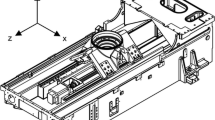Abstract
The determination of material damping ratios in machine tools is afflicted with considerable uncertainties. For the estimation of damping ratios different methods are available, each with specific model assumptions and parameters. Depending on the experience already gained with one method, the quality of the resulting values therefore can vary considerably. This paper proposes the simultaneous application of two different calculation methods, namely the logarithmic decrement and the bandwidth method, to the same measured signal. Assuming a decaying, time-limited and very lightly damped response signal, both methods cannot be applied in their original form. Therefore a filter-based logarithmic decrement and a frequency resolution enhanced bandwidth method are used. To demonstrate the capability of the approach, both methods are applied to an analytical three-degree-of-freedom system derived from a measured structure. The damping ratios yielded by both methods deviate less than 1 % from the analytical value. Furthermore, in a real measurement with uncertain system properties and parameter choice, the combined use of both methods can be used to assess the uncertainty of the obtained values. The capability of the proposed method is demonstrated on the basis of the measurement of a small machine tool component.









Similar content being viewed by others
Notes
The nomenclature of compliance α(ω), mobility Y(ω) and inertance A(ω) is chosen corresponding to Maia and Silva [12].
References
Ruzicka JF (ed) (1959) Structural damping, chap 5–Measurement of damping. American Society of Mechanical Engineers, New York, pp 117–131
VDI 3830 Part 5 (2004) Damping of materials and members–experimental techniques for the determination of damping characteristics. Standard, available from: Verein deutscher Ingenieure. http://www.vdi.de
Chu FH, Wang BP (1980) Experimental determination of damping in materials and structures. In: Damping applications for vibration control. American Society of Mechanical Engineers, New York, The winter annual meeting of the American Society of Mechanical Engineers, Chicago, 16–21 Nov 1980, pp 113–122
Cooper JE (1996) Parameter estimation methods for flight flutter testing. In: Advanced aeroservoelastic testing and data analysis, Advisory Group for Aerospace Research & Development, Neuilly-sur-Seine, AGARD conference proceedings, vol 566, pp 10-1–10-12
Seybert AF (1981) Estimation of damping from response spectra. J Sound Vib 75(2):199–206
Staszewski WJ (1996) Identification of damping in MDOF systems using time-scale decomposition. J Sound Vib 203(2):283–305
Koruk H, Sanliturk K (2011) Damping uncertainty due to noise and exponential windowing. J Sound Vib 330:5690–5706
Antoni J (2006) Leakage-free identification of FRFs with the discrete time fourier transform. J Sound Vib 294:981–1003
Verboven P, Parloo E, Cauberghe B, Guillaume P (2005) Improved modal parameter estimation for lowly damped systems using non-parametric exponential windowing techniques. Mech Syst Signal Process 19:675–699
Randall B (1987) Frequency analysis. 3rd edn. Bruel & Kjaer, Naerum
Shannon CE (1949) Communication in the presence of noise. Proc IRE 37(1):10–21
Maia NM, Silva JM (eds) (1997) Theoretical and experimental modal analysis. Wiley, Chicester
Anthony DK, Simón F (2010) Improving the accuracy of the n-DB method for determining damping of non-lightly damped systems. Appl Acoust 71:299–305
Gawronski WK (2004) Advanced structural dynamics and active control of structures. 9th edn. Springer, New York
van Tomme J (1988) Evaluation of damping measurements in materials and structures. In: Proceedings of 13th international seminar on modal analysis, part I/12, Katholieke Universiteit Leuven, Belgium
Norton M, Greenhalgh R (1986) On the estimation of loss factors in lightly damped pipeline systems: some measurement techniques and their limitations. J Sound Vib 105(3):397–423
Liao Y, Wells V (2011) Modal parameter identification using the log decrement method and band-pass filters. J Sound Vib 330:5014–5023
Agneni A, Balis-Crema L (1989) Damping measurements from truncated signals via Hilbert transform. Mech Syst Signal Process 3(1):1–13
Spitznogle FR, Quazi AH (1969) Representation and analysis of time-limited signals using a complex exponential algorithm. J Acoust Soc Am 47(5):1150–1155
Verdun FR, Giancaspro C, Marshall AG (1988) Effects of noise, time-domain damping, zero-filling and the FFT algorithm on the “exact” interpolation of fast Fourier transform spectra. Appl Spectrosc 42(5):715–721
Bousman WG, Winkler DJ (1981) Application of the moving-block analysis. In: 22nd AIAA/ASME/ASCE/AHS structures, structural dynamics and materials conference, American Institute of Aeronautics and Astronautics, Atlanta, pp 755–763
Institute of Electrical and Electronics Engineers (ed) (1979) Programs for digital signal processing. IEEE Press, New York
Rabiner LR, Schafer RW (1969) The chirp z-transform algorithm. IEEE Trans Audio Electroacoust 17(2):86–92
Acknowledgments
This work was supported by the German Research Foundation (DFG) within the research unit FOR-1087 “Damping effects in Machine Tools”.
Author information
Authors and Affiliations
Corresponding author
Rights and permissions
About this article
Cite this article
Niehues, K., Schwarz, S. & Zaeh, M.F. Reliable material damping ratio determination in machine tool structures. Prod. Eng. Res. Devel. 6, 475–484 (2012). https://doi.org/10.1007/s11740-012-0393-7
Received:
Accepted:
Published:
Issue Date:
DOI: https://doi.org/10.1007/s11740-012-0393-7




